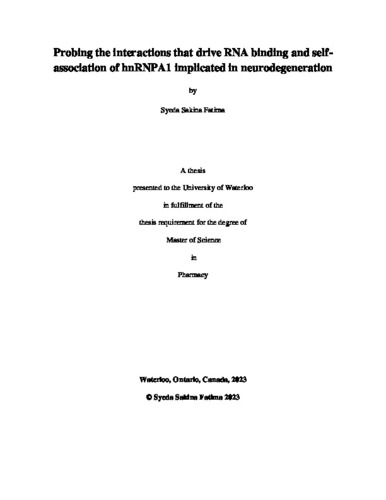| dc.description.abstract | The heteronuclear ribonucleoprotein A1 (hnRNPA1 or A1) is associated with the pathology of different diseases, including neurological disorders and cancers. In particular, the aggregation and dysfunction of A1 has been identified as a critical driver for neurodegeneration in Multiple Sclerosis (MS). Structurally, A1 includes a low-complexity domain (LCD) and two RNA-recognition motifs (RRMs), and their interdomain coordination may play a crucial role in A1 aggregation. Previous studies propose that RNA-inhibitors or nucleoside analogs that bind to RRMs can potentially prevent A1 self-association. Therefore molecular-level understanding on the RNA recognition by A1 RRMs remains of scientific interest. Although several crystal structures of RNA-bound RRM complexes have been reported in the literature, there are still open questions about which RRM RNA prefers to bind and why only specific RNA sequences tend to bind A1. This thesis aims at probing the structures, dynamics and nucleotide interactions with A1’s RRMs using a combination of advanced computational methods. Our research to-date has revealed that adenine and guanine in RNAs (or DNAs), and the key residues from the interdomain linker connecting the two RRM domains contribute significantly for RNA binding to A1 RRMs. Further research will seek to address the impact of RNA length on its binding and how RNA specificities vary between the RRMs. Critical residues for RNA-binding have been identified and their molecular-level insights on their nucleotide preferences have been evaluated. As a final addition, the full-length A1 protein for which a crystal structure in the PDB does not exist, is modeled, to analyze the interactions that occur between the RRMs and the LCD domain that could promote A1’s aggregation. Both of A1’s known isoforms, isoform A (320aa) and isoform B (372aa) have been modeled and studied, with and without RNA bound to them. Our data suggests that interplay between the LCD and the RRMs may block exposure of critical RNA-binding residues to the environment when RNA is not already bound to the protein. Taken together, this thesis elaborates on full protein dynamics and nucleotide-protein interactions that may be helpful in designing therapeutics. Nucleotide-based therapies or nucleoside analogs in particular, can be designed based on specific interactions outlined in this thesis. | en |

